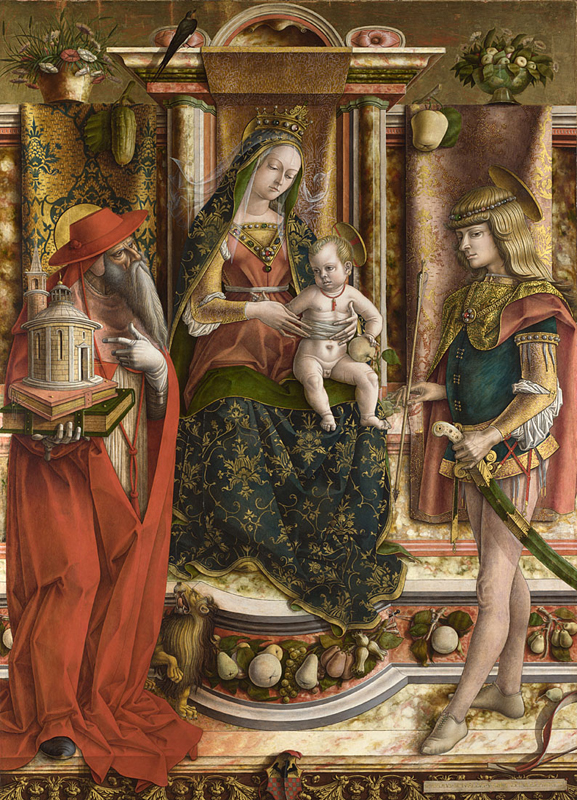
Someone mentioned in an email that that this week he had seen his first swallow of spring out at Gosford. Perhaps the swallow in this altarpiece, which is perched above the Madonna and Child and gives the work its name, had just arrived in Heaven from somewhere south of the Sahara. For this is a heavenly scene and is as fine a picture as you will ever find of Our Lady enthroned as Queen in Heaven. Jesus said “I go now to prepare a place for you” (Jn 14:2) Crivelli evokes the transcendent splendour of a place in Heaven by using the most beautiful and fashionable things of this earthly life.

The swallow is significant. Not only is the bird a herald of spring and new life, but in 15th Century Italy it symbolised both Christ and Mary. There was a rather gruesome legend that if you should pluck out the eyes of swallow chicks, then the parent would take a blade a grass and use it to restore their eyesight. So the swallow symbolised Christ, who restored sight to the blind. But because this bird took such care in building a nest for her chicks , the bird also symbolised maternal love and therefore the love of the Madonna for her child and for us too.
This heavenly picture is about Mary and much of its rich symbolism centres on her maternal love. But of all the many paintings by Crivelli of the Virgin and Child, this is the only one in which the child is shown without clothes. To show the Christ child naked was quite common in late medieval and early modern art. The idea was to lay emphasis on the full humanity of Christ.
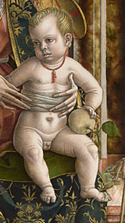
But if the humanity of Christ is being emphasised through a lack of clothes, the transcendent splendour of Heaven and of Mary enthroned is shown through the finest clothing and cloth of the day. This painting shows Mary as Queen of Heaven.
This altarpiece was made for the Ottoni family chapel in the Franciscan Church of the Marche town of Matelica. The Ottoni were the Lords of Matelica. Their family name derived from the Emperor Otto I, who, they claimed, granted them the right to bear the Emperor’s name in 962. Historically, they were knights which meant that, among other things, they had been posh mercenaries. Judging by this picture, they had become very style-conscious. They and their town of Matelica had become wealthy through the production of wool and textiles. No doubt, this fact explains such a particularly textile-rich take on Heaven. Saints Jerome and Sebastian, who attend their Queen, are turned out in their finest. We see St Jerome, not as we usually do, stripped to do penance, but robed in a splendid and luxuriant red cappa and hat. Crivelli lets the bright red cloth trail over the front step. St Sebastian is fully clothed as well, which is unusual for him. He is dressed as a fashion-conscious knight of the day would have been. The only allusions to him as a plague saint is the single arrow he holds in his right hand and the bow at his feet, which is there to show that he can deal with the arrows of the plague should they begin to fly. St Sebastian was also a soldier. Clearly, the Ottoni wanted him shown as a knight, who might frequent their own court. He is their representative in Heaven. At the very bottom, we see their coat of arms carved on the step, which tells you that this is their take on Heaven.
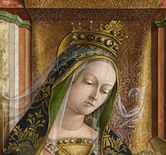
Of course, Mary is the most splendidly arrayed of all. Notice her golden sleeves. Crivelli has given another similar pair to St Sebastian. She wears a crown and, rather interestingly, two veils. One is beneath her mantle. It may be a sign of her betrothal to St Joseph. But there is another just under her crown. This one symbolises her betrothal to God. Behind her Crivelli hangs two lengths of expensive cloth. The colours are different but the pattern is the same.
As you would expect from Crivelli, there is a lot of fruit lying about in this Heavenly court. Apples recall the first Eve, and so, by association, Mary’s status as the second Eve. Peaches and pears are reminders of her Son’s passion. The cucumber on the upper left is a symbol of Christ’s death and resurrection. This symbolism derives from the story of Jonah who spent three days in the belly of a whale and who was associated with a gourd. The cucumber looks like one, or so I read somewhere in a book!
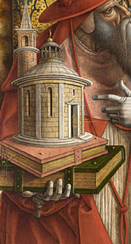
One unusual feature of the history of this altarpiece is that the Franciscans met most of the cost. They paid 310 florins, whereas the Ottoni contributed only 60 ducats. The local Franciscan Guardian, Fra Giorgio di Giacomo, was very “church-proud” and seems to have been the driving force behind the range of Renaissance side-chapels built on to the church in this period. This fact may explain why St Jerome holds a very Renaissance looking church. This is the standard pose of a saintly founder. But it is the importance of the church building itself with its modern design and beautiful interior which is emphasised. St Jerome points to the golden rays emerging from the open door, lest we miss the point. He represents this church enhancing friar! These side chapels were deep and narrow with a round window on the back wall. Altars were built on the side walls. In this picture, light descends from the upper left, as did the natural light. So really, you have to imagine this work against the wall in that poorly lit side chapel at the very moment when bright Italian sunshine streams down and picks out the the gold in all the fabrics and clothing.
There is am important difference between this work and earlier altarpieces by Crivelli. Mostly, his altarpieces were polytychs: that is a number of saints painted on individual panels, each in his or her own niche, arranged around a central panel showing the main saint. Usually, but not always, the Madonna and Child would be in the centre with a Pietà above them. The framing would be gothic in style with characteristic pointed arches. But this work is not a polytych. It is a pala which is a fixed arrangement of a large main painting with a row of smaller paintings below in what was known as the predella. This particular work is unusual in that it is still in its original frame with the predella pictures below. This was latest thing in Italian Renaissance style. Gone are all those the Gothic arches and golden backgrounds! The broad rectangular frame of this pala is decorated as if it were a set of pillars in a Renaissance palazzo. In fact, in 1482 the Ottoni family had rebuilt their palazzo in this style on the town’s main piazza.
Very little is known about Crivelli’s personal life. He and his brother were Venetian artists as was their father. In 1457, he was imprisoned for adultery with the wife of a sailor. He then left Venice and there is no record of him ever returning. However , he signed himself as “Venetus”. Crivelli settled first at Zara in Dalmatia, but then moved to Ascoli in the Marche and had a very successful career painting altarpieces for the churches in the region. The Franciscans were major patrons and also the Dominicans. Despite his consumate draughtsmanship, his beautiful use of colour, his exquisite rendering of detail and its rich symbolism, Crivelli was largely forgotten by art historians. He was a contemporary of Mantegna and Bellini and his work shows their influences. In the nineteenth Century his works became popular with British collectors. No doubt, this is why there are so many in London’s National Gallery collection. Unfortunately, many of his altarpieces were dismembered and then sold in different lots. The Madonna della Rondine wasn’t and it is still in its original frame, which makes it all the more precious. Perhaps if Crivelli had stayed on in Venice, his works would have been more widely known and loved sooner.
Ascoli, where he lived, was quite near the border with the Kingdom of Naples and it came under Neopolitan rule in the final decade of Crivelli’s life. The King of Naples knighted Crivelli in 1490. His signature, written in gold letters at the bottom right proclaims this fact. When the sun rose and streaming to the side chapel, the viewer would read not just his name but his new status as a knight (in Latin “Miles”): CAROLUS CRIVELLUS VENETUS MILES PINXIT.
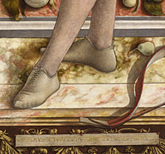
Despite the evident mixed motivations in its making, this very beautiful painting of Our Lady crowned Queen of Heaven, with her recently arrived swallow in attendance, is surely one for this month of May, which is Mary’s month. Our Lady of the Swallow, pray for us!
The Catholic Chaplaincy serves the students and staff of the University of Edinburgh, Edinburgh Napier University and Queen Margaret University.
The Catholic Chaplaincy is also a parish of the Archdiocese of St Andrews and Edinburgh (the Parish of St Albert the Great) and all Catholic students and staff are automatically members of this parish.